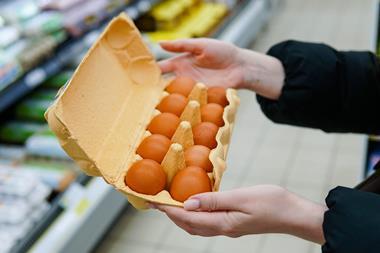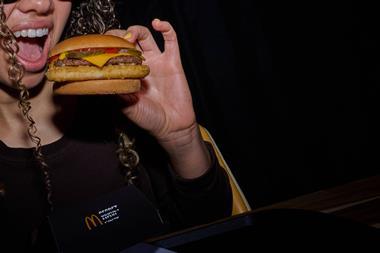And how much more growth can be generated from the already mature added value sector?
To date poultry and turkey suppliers have been masterful at defending their sales against the notorious strains of the British meat market.
Twenty years ago poultry accounted for approximately a fifth of overall meat volume. Now it accounts for over 40%. And new product development in added value and convenience mean poultry is now growing faster in value than it is in volume, with its sheer versatility making life easier.
The fresh and frozen primary market grew just 3% in value last year, but fresh processed poultry shot up 13% in value.
If it's chilled and it's convenient, customers go for it. The true star of the show has been relative newcomer chilled chicken roll roasts, up 89% in value in the year to May [Taylor Nelson Sofres]. Suppliers have successfully altered the perception of the roast as a weekend meal, and created products of varying sizes tailored to be convenient midweek meal solutions with little waste, and higher frequency of purchase.
In both fresh and frozen, ways of presenting poultry breaded, unbreaded, marinated, dusted and wrapped have been developed alongside a profusion of further processed products nuggets, bites, kievs, escalopes, portions and other recipe dishes. There is a record number of different stuffings and marinades available not just to add interest, but also widen the appeal of poultry to a diverse population.
Suppliers like Sun Valley have been making the traditional roast more appealing through flavourings.
Sun Valley says it is extremely pleased with the success of its Ready2Roast added value range of bagged chickens, with flavourings including Rotisserie, Garlic, Lime & Coriander and Original. The product consists of a 1.5kg or 1.8kg whole fresh chicken in an unique self venting roasting bag with four flavoured variations: rotisserie, garlic, sage and onion with stuffing, and the recently introduced lime and coriander.
Eleanor Baker, Sun Valley's primary marketing manager, says: "Consumers enjoy the convenience of the product it requires the minimum level of handling during preparation and cooking, a major concern with raw poultry.
"We also discovered the majority of people were using the product at the weekend or when entertaining. Therefore as part of the relaunched range, with a new look and packaging, we increased the size of the chickens from the original 1.1kg bird to two different options 1.5kg or 1.8kg. This move has been well received by retailers and customers and sales have increased significantly as a result."
Sun Valley plans new additions to the range in the next six to 12 months.
But generally the whole bird, in this age of convenience, is in the doldrums. Sales of whole birds both fresh and frozen are down year-on-year, though Easter and Christmas sales defy the trend. Commodity poultry is under pressure from frozen or chilled ready meals, and relying heavily on deals to keep volume buoyant, though there has been growth in the premium arena.
Bernard Matthews' marketing services co-ordinator Lorna Marshall-Sully says: "Whole birds used to be a family occasion. However people now want convenient, easy to cook and carve products with no waste for their family due to much busier lifestyles.
"There has been a move towards more natural cuts of meat, which has in turn meant some prices have increased. Consumers are now very concerned about where their food comes from full traceability is imperative and if a cut is more natural, feel that this has obviously been less tampered with than a more processed poultry product.
"There has also been a move to very premium products being created for that one-off special occasion."
Creating a carcase meat brand capable of yielding a price premium even in the commodity markets where the most lightly processed cuts and joints are traded has been the ambition of many major suppliers for decades. Most have failed and the few successes seem to have been as much by accident as design. Nevertheless Grampian Country Food Group reckons a disciplined marketing and promotional campaign will work for chicken, persuading consumers to pay 10%-15% more for the company's name as a symbol of integrity in the production system and reliable quality of product.
Grampian's latest campaign launched in Scotland on August 20, and planned for national roll out early next year, is an audacious bid to prove the principle can now be applied right across the range from the predictable 500g four-pack of fillets to the 3kg Super Roaster whole bird.
Between the two extremes are larger packs of fillets, 400g diced packs, 550-750g drumsticks x4, 750-950g thigh x4 and whole birds of 2-2.49kg, but the potential consumer appeal demonstrated by market research is linked to Grampian's taking as the starting point its distinctive, familiar large chicken, and its short integrated supply chain.
In the ready meal arena, novelty isn't everything. Many offers make sure they include the traditional' as part of the marketing. Perkins Foods describes its new Restaurant Express ready meal range as a response to "high demand from the retail industry for quality food to go' which still provides the traditional food values".
Perkins' NPD reflects the vital selling points of convenience and added value, with the recent launch of premium sliced chicken and turkey for the prepacked sector, providing convenient portions for sandwiches. Earlier this year subsidiary Valley Park launched a premium Mediterranean style chicken breast layered with Italian raw ham.
Birds Eye trading director Neil Jones acknowledges his company and its competitors are battling in a market "close to saturation of food centres" yet claim "poultry and fish will continue to grow, but red meat could suffer".
The frozen poultry category is worth £310m annually, according to Birds Eye Wall's. It's a category in small value decline, but volume growth, says the company. Volume growth is generated by frozen poultry relying heavily on deals, with 55% sold on deal (with Kievs the main area).
Birds Eye can point to "great value and even better volume growth" in the Family sector, but is worried about the decline in the Children and Adult areas of the industry generally.
Jones says: "The only adult sub-sector in strong value growth is uncoated grills, dominated by our Chargrills range, now worth over £25m, and further boosted by the launch of Honey & Mustard Chicken and Thai Chicken last September. These two varieties are now worth over £8m annually. And we are building on this with Cracked Pepper Chicken, launched this month.
"With all other subsectors in the adult segment in decline there's a great opportunity to introduce more contemporary products."
Jones adds: "As it's the biggest sector, the decline in children's poultry is of concern."
In this area, BEW this month launched the new Chicken O's.
Jones says: "The original Chicken O was launched in August 1999 and despite being successful we felt we could make it better." The original was six pieces of chicken packed in a foil oval shaped package. The new version is 10 pieces of chicken in a new smaller size easier for smaller hands to grab and dip. "The new pack allows better portionability and the funky new box has a special easy open/ recloseable feature to stop mess in the freezer," says Jones.
Birds Eye Wall's flags up quality assurance, with sourcing "from a selected group of trusted farms".
BEW is also pushing the children's sector with its LegoLand ticket promotion on Crispy Chicken Dippers. Each pack lets one child in free to LegoLand Windsor.
Today, 64% of the British turkey market is dominated by convenient cuts and added value presentations, in marked contrast to 10 years ago, when whole bird sales accounted for 60% of the turkey market. Fresh portions now account for more than 23% of all UK turkey sales [TN Sofres, 52 weeks to June].
Since then the rolls and roasts presentations have taken on the mantle as the fastest growing sector, recording massive leaps in consumption in the five years to 2001, rising more than 170% to 21,715 tonnes and with value sales rising from £40.4m to £99.3m.
In the last year alone, sales of rolls and roasts have grown by 16% while tonnage has climbed 12%.
Many producers have concentrated their efforts on developing innovative presentations including stuffings, glazes and coatings to provide increased consumer appeal in-store.
Now in its third year, the British Turkey Quality Assurance Scheme and accompanying Mark covers more than 80% of UK turkey production.
Maire Burnett of the British Turkey Federation says: "Turkey meat benefits from being the lowest in fat and highest protein of all the meats ensuring its long-term future in the eyes of an increasingly health conscious shopper. Coupled with the low weekly penetration levels we believe there is a huge sales potential for retailers all year round. British turkey has also shown its ability to hold its own in a declining primary meat market, retaining a steady market share of 8.5%."
{{FOCUS SPECIALS }}
Close menu
- Home
- Retail & Wholesale
-
Products & Suppliers
- Back to parent navigation item
- Products & Suppliers
-
Product Categories:
- Back to parent navigation item
- Product Categories:
- Alcoholic drinks
- Bakery
- Cereals & breakfast
- Cheese
- Chicken & poultry
- Chocolate
- Confectionery
- Crisps, nuts & snacks
- Dairy
- Fish
- Fresh produce
- Frozen
- Household
- Meat
- Own Label
- Sauces & condiments
- Seasonal
- Soft drinks
- Vaping
- Vegan & plant-based
- World foods
- Suppliers
- People
- Reports & Data
-
Topics A-Z
- Back to parent navigation item
- Topics A-Z
-
Popular topics:
- Back to parent navigation item
- Popular topics:
- Cost of living crisis
- Crime
- Deposit Return Schemes
- Finance
- Government & Regulation
- Health
- Inflation
- Loyalty
- Marketing
- Mergers & Acquisitions
- New Product Development
- Sourcing
- Supply chain
- Sustainability & environment
- Technology
- Ultra Processed Foods
- Vaping
- A-Z all topics
- Content by type:
- Events
- Ask iA (beta)
- Subscribe now
Sign in to comment on this article
Not logged in before? Register for FREE guest access today.
You will be able to:
- Read more stories
- Receive daily newsletters
- Comment on stories
Advert


















No comments yet